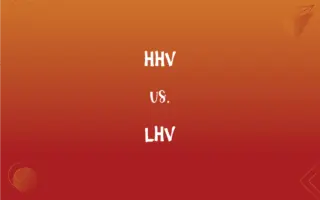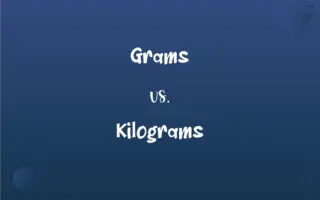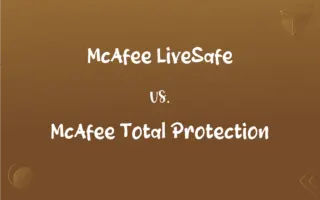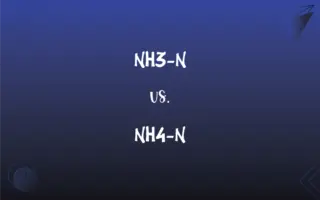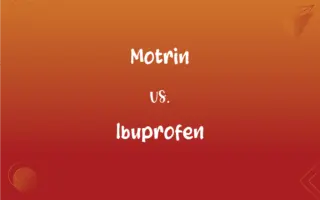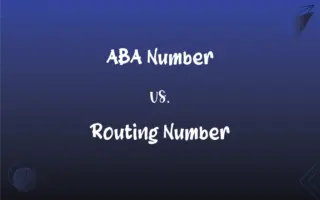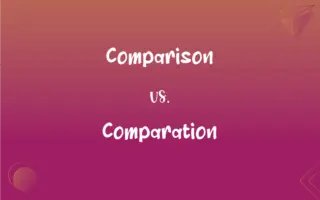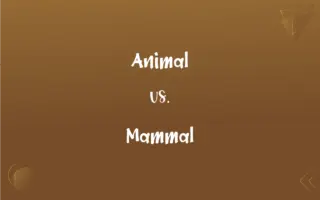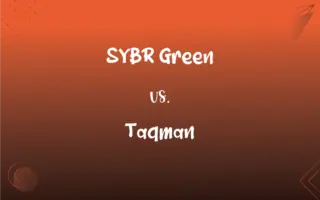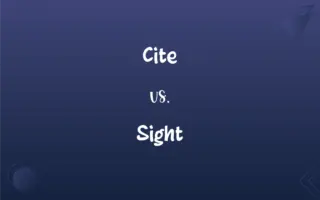Hem vs. Seam: What's the Difference?
By Janet White & Harlon Moss || Updated on May 20, 2024
Hem refers to the edge of a piece of fabric that is folded and sewn to prevent fraying, whereas a seam is the line where two pieces of fabric are stitched together.

Key Differences
A hem is created by folding the edge of the fabric over and stitching it down to prevent fraying and provide a clean finish. This technique is commonly used on the edges of garments, curtains, and other fabric items. Hemming adds durability and a polished look to the fabric's edges. A seam, on the other hand, is formed when two pieces of fabric are sewn together along their edges. Seams are essential in constructing garments and other fabric items, as they join different pieces to form a complete structure. The strength and type of seam used can affect the durability and appearance of the finished product.
Hems are typically found at the bottoms of skirts, pants, sleeves, and other edges where a clean finish is desired. While a hem is usually visible on the outside of the garment, it can be decorative or hidden depending on the sewing technique used. Seams can be plain, flat-felled, or French, among other types, and are often found at the sides of garments, shoulder lines, and in the construction of bags and home textiles. The choice of seam type depends on the fabric and the desired strength and appearance.
Both hems and seams require careful measuring and sewing techniques to ensure they are even and secure. While a hem is more about finishing the edges, a seam is about joining pieces together.
Hems can also include decorative stitching or embellishments, adding an aesthetic element to the functional purpose. Seams, while primarily functional, can also be designed to be decorative or feature topstitching for added strength and style.
Comparison Chart
Definition
Edge fold sewn to prevent fraying
Line where two pieces of fabric are sewn
ADVERTISEMENT
Primary Function
Finishing edges
Joining fabric pieces
Location
Edges of garments, curtains, etc.
Sides of garments, shoulder lines, etc.
Visibility
Usually visible, can be decorative
Can be hidden or decorative
Types
Double fold, rolled, blind
Plain, flat-felled, French
Hem and Seam Definitions
Hem
A technique used in garment making.
She used a blind hem stitch for a clean look.
ADVERTISEMENT
Seam
The joining of two pieces of material.
The seam of the pillowcase was expertly stitched.
Hem
The edge of a piece of fabric folded and sewn to prevent fraying.
The hem of her dress was elegantly finished.
Seam
A line where two pieces of fabric are sewn together.
The seam on the side of the shirt had come undone.
Hem
(sewing) The border of an article of clothing doubled back and stitched together to finish the edge and prevent it from fraying.
Seam
A line of junction formed by sewing together two pieces of material along their margins.
Hem
A rim or margin of something.
Seam
A similar line, ridge, or groove made by fitting, joining, or lapping together two sections along their edges.
Hem
In sheet metal design, a rim or edge folded back on itself to create a smooth edge and to increase strength or rigidity.
Seam
A suture.
Hem
To make the sound expressed by the word hem; to hesitate in speaking.
Seam
A scar.
Hem
To make a hem.
Seam
A line across a surface, as a crack, fissure, or wrinkle.
Hem
A method to finish the raw edges of fabric.
He carefully hemmed the edges of the tablecloth.
Seam
A thin layer or stratum, as of coal or rock.
Hem
A decorative finish on the edge of a fabric.
The hem was adorned with intricate lace.
Seam
To put together with or as if with a seam.
Hem
An edge or border on a piece of cloth, especially a finished edge, as for a garment or curtain, made by folding an edge under and stitching it down.
Seam
To mark with a groove, wrinkle, scar, or other seamlike line.
Hem
The height or level of the bottom edge of a skirt, dress, or coat; a hemline.
Seam
To become fissured or furrowed; crack open.
Hem
A short cough or clearing of the throat made especially to gain attention, warn another, hide embarrassment, or fill a pause in speech.
Seam
(sewing) A folded-back and stitched piece of fabric; especially, the stitching that joins two or more pieces of fabric.
Hem
To fold back and stitch down the edge of.
Seam
A suture.
Hem
To surround and shut in; enclose
A valley hemmed in by mountains.
Seam
(geology) A thin stratum, especially of an economically viable material such as coal or mineral.
Hem
To utter a hem.
Seam
(cricket) The stitched equatorial seam of a cricket ball; the sideways movement of a ball when it bounces on the seam.
Hem
To hesitate in speech.
Seam
A joint formed by mating two separate sections of materials.
Seams can be made or sealed in a variety of ways, including adhesive bonding, hot-air welding, solvent welding, using adhesive tapes, sealant, etc.
Hem
Used to fill in the gap of a pause with a vocalized sound.
Seam
A line or depression left by a cut or wound; a scar; a cicatrix.
Hem
An utterance or sound of the voice like "hem", often indicative of hesitation or doubt, sometimes used to call attention.
Seam
(figurative) A line of junction; a joint.
Hem
(transitive) To put hem on an article of clothing, to edge or put a border on something.
Seam
(historical) An old English measure of grain, containing eight bushels.
Hem
(transitive) To shut in, enclose, confine; to surround something or someone in a confining way.
A small yard hemmed about by a tall hedge.
Seam
(historical) An old English measure of glass, containing twenty-four weys of five pounds, or 120 pounds.
Hem
Obsolete form of 'em
Seam
Grease; tallow; lard.
Hem
Them
Seam
To put together with a seam.
Hem
An onomatopoetic word used as an expression of hesitation, doubt, etc. It is often a sort of voluntary half cough, loud or subdued, and would perhaps be better expressed by hm.
Cough or cry hem, if anybody come.
Seam
To make the appearance of a seam in, as in knitting a stocking; hence, to knit with a certain stitch, like that in such knitting.
Hem
An utterance or sound of the voice, hem or hm, often indicative of hesitation or doubt, sometimes used to call attention.
Seam
To mark with a seam or line; to scar.
Hem
The edge or border of a garment or cloth, doubled over and sewed, to strengthen it and prevent raveling.
Seam
To crack open along a seam.
Hem
Border; edge; margin.
Seam
(cricket) Of the ball, to move sideways after bouncing on the seam.
Hem
A border made on sheet-metal ware by doubling over the edge of the sheet, to stiffen it and remove the sharp edge.
Seam
(cricket) Of a bowler, to make the ball move thus.
Hem
To make the sound expressed by the word hem; hence, to hesitate in speaking.
Seam
Grease; tallow; lard.
Hem
To form a hem or border to; to fold and sew down the edge of.
Seam
The fold or line formed by sewing together two pieces of cloth or leather.
Hem
To border; to edge
All the skirt aboutWas hemmed with golden fringe.
Seam
Hence, a line of junction; a joint; a suture, as on a ship, a floor, or other structure; the line of union, or joint, of two boards, planks, metal plates, etc.
Precepts should be so finely wrought together . . . that no coarse seam may discover where they join.
Hem
Lap that forms a cloth border doubled back and stitched down
Seam
A thin layer or stratum; a narrow vein between two thicker strata; as, a seam of coal.
Hem
Fold over and sew together to provide with a hem;
Hem my skirt
Seam
A line or depression left by a cut or wound; a scar; a cicatrix.
Hem
Utter `hem' or `ahem'
Seam
A denomination of weight or measure.
Hem
The bottom edge of a garment.
The pants' hem was frayed from frequent wear.
Seam
To form a seam upon or of; to join by sewing together; to unite.
Seam
To mark with something resembling a seam; to line; to scar.
Seamed o'er with wounds which his own saber gave.
Seam
To make the appearance of a seam in, as in knitting a stocking; hence, to knit with a certain stitch, like that in such knitting.
Seam
To become ridgy; to crack open.
Later their lips began to parch and seam.
Seam
Joint consisting of a line formed by joining two pieces
Seam
A slight depression in the smoothness of a surface;
His face has many lines
Ironing gets rid of most wrinkles
Seam
A stratum of ore or coal thick enough to be mined with profit;
He worked in the coal beds
Seam
Put together with a seam;
Seam a dress
Seam
A method of constructing garments.
She used a French seam for a neat finish.
Seam
A point of connection in fabric.
The seams of the dress were barely visible.
Seam
A line created by sewing.
He checked the seams to ensure they were straight.
FAQs
What is the main purpose of a hem?
The main purpose of a hem is to finish the edge of a fabric to prevent fraying and provide a neat appearance.
Where are seams commonly found?
Seams are found at the sides of garments, shoulder lines, and in the construction of various fabric items.
What is a hem?
A hem is the edge of a piece of fabric that is folded and sewn to prevent fraying and create a clean finish.
Can seams be decorative?
Yes, seams can be decorative or feature topstitching for added style.
Can hems be decorative?
Yes, hems can be decorative with stitching or embellishments.
What is a seam?
A seam is the line where two pieces of fabric are stitched together, forming the structure of a garment or fabric item.
How is a hem made?
A hem is made by folding the fabric edge and stitching it down.
Where are hems commonly found?
Hems are commonly found at the bottoms of skirts, pants, sleeves, and other fabric edges.
What is the main purpose of a seam?
The main purpose of a seam is to join two pieces of fabric together.
What are some types of hems?
Some types of hems include double fold, rolled, and blind hems.
What are some types of seams?
Some types of seams include plain, flat-felled, and French seams.
Can seams be reinforced?
Yes, seams can be reinforced with extra stitching or binding.
Can hems be reinforced?
Yes, hems can be reinforced with additional stitching.
Are seams visible?
Seams can be hidden or decorative, depending on the construction.
How is a seam made?
A seam is made by aligning two fabric pieces and sewing them together.
Are hems visible?
Hems are usually visible and can be decorative or hidden.
What is a blind hem?
A blind hem is a type of hem that is almost invisible from the outside.
What tools are needed for hemming?
Tools for hemming include needles, thread, and a sewing machine.
What tools are needed for sewing seams?
Tools for sewing seams include needles, thread, a sewing machine, and sometimes seam binding tape.
What is a French seam?
A French seam is a type of seam that encases the raw edges for a neat finish.
About Author
Written by
Janet WhiteJanet White has been an esteemed writer and blogger for Difference Wiki. Holding a Master's degree in Science and Medical Journalism from the prestigious Boston University, she has consistently demonstrated her expertise and passion for her field. When she's not immersed in her work, Janet relishes her time exercising, delving into a good book, and cherishing moments with friends and family.
Co-written by
Harlon MossHarlon is a seasoned quality moderator and accomplished content writer for Difference Wiki. An alumnus of the prestigious University of California, he earned his degree in Computer Science. Leveraging his academic background, Harlon brings a meticulous and informed perspective to his work, ensuring content accuracy and excellence.















